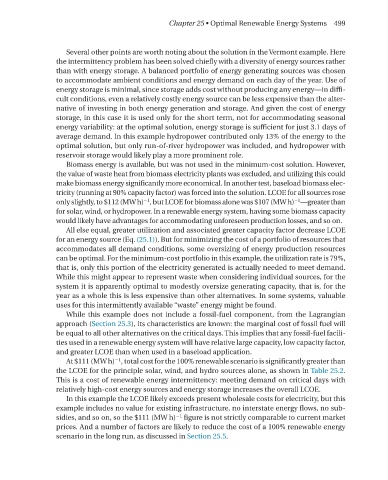Page 486 - A Comprehensive Guide to Solar Energy Systems
P. 486
Chapter 25 • Optimal Renewable Energy Systems 499
several other points are worth noting about the solution in the Vermont example. here
the intermittency problem has been solved chiefly with a diversity of energy sources rather
than with energy storage. A balanced portfolio of energy generating sources was chosen
to accommodate ambient conditions and energy demand on each day of the year. Use of
energy storage is minimal, since storage adds cost without producing any energy—in diffi-
cult conditions, even a relatively costly energy source can be less expensive than the alter-
native of investing in both energy generation and storage. And given the cost of energy
storage, in this case it is used only for the short term, not for accommodating seasonal
energy variability: at the optimal solution, energy storage is sufficient for just 3.1 days of
average demand. in this example hydropower contributed only 13% of the energy to the
optimal solution, but only run-of-river hydropower was included, and hydropower with
reservoir storage would likely play a more prominent role.
Biomass energy is available, but was not used in the minimum-cost solution. however,
the value of waste heat from biomass electricity plants was excluded, and utilizing this could
make biomass energy significantly more economical. in another test, baseload biomass elec-
tricity (running at 90% capacity factor) was forced into the solution. LCOE for all sources rose
−1
−1
only slightly, to $112 (MW h) , but lCoE for biomass alone was $107 (MW h) —greater than
for solar, wind, or hydropower. in a renewable energy system, having some biomass capacity
would likely have advantages for accommodating unforeseen production losses, and so on.
All else equal, greater utilization and associated greater capacity factor decrease lCoE
for an energy source (Eq. (25.1)). But for minimizing the cost of a portfolio of resources that
accommodates all demand conditions, some oversizing of energy production resources
can be optimal. For the minimum-cost portfolio in this example, the utilization rate is 79%,
that is, only this portion of the electricity generated is actually needed to meet demand.
While this might appear to represent waste when considering individual sources, for the
system it is apparently optimal to modestly oversize generating capacity, that is, for the
year as a whole this is less expensive than other alternatives. in some systems, valuable
uses for this intermittently available “waste” energy might be found.
While this example does not include a fossil-fuel component, from the lagrangian
approach (section 25.3), its characteristics are known: the marginal cost of fossil fuel will
be equal to all other alternatives on the critical days. This implies that any fossil-fuel facili-
ties used in a renewable energy system will have relative large capacity, low capacity factor,
and greater lCoE than when used in a baseload application.
−1
At $111 (MW h) , total cost for the 100% renewable scenario is significantly greater than
the lCoE for the principle solar, wind, and hydro sources alone, as shown in Table 25.2.
This is a cost of renewable energy intermittency: meeting demand on critical days with
relatively high-cost energy sources and energy storage increases the overall lCoE.
in this example the lCoE likely exceeds present wholesale costs for electricity, but this
example includes no value for existing infrastructure, no interstate energy flows, no sub-
−1
sidies, and so on, so the $111 (MW h) figure is not strictly comparable to current market
prices. And a number of factors are likely to reduce the cost of a 100% renewable energy
scenario in the long run, as discussed in section 25.5.

